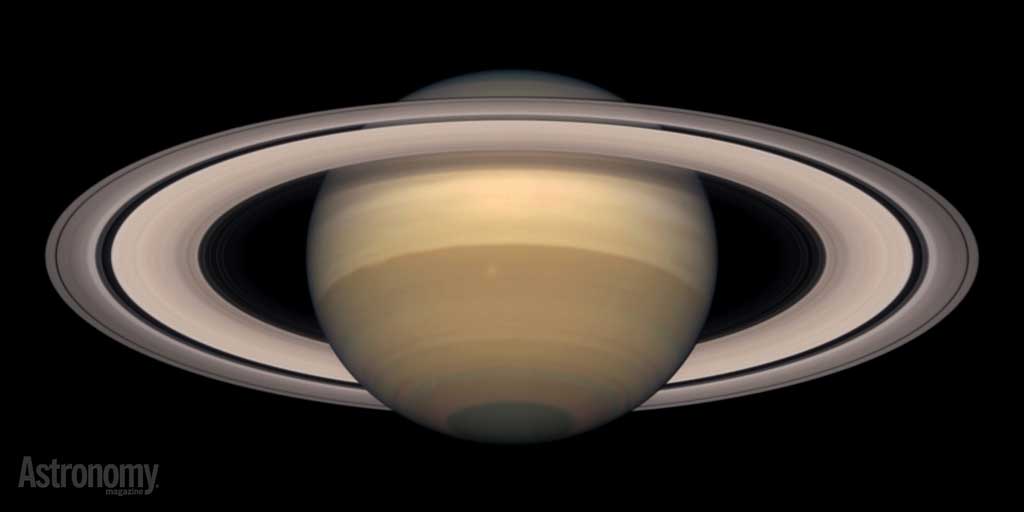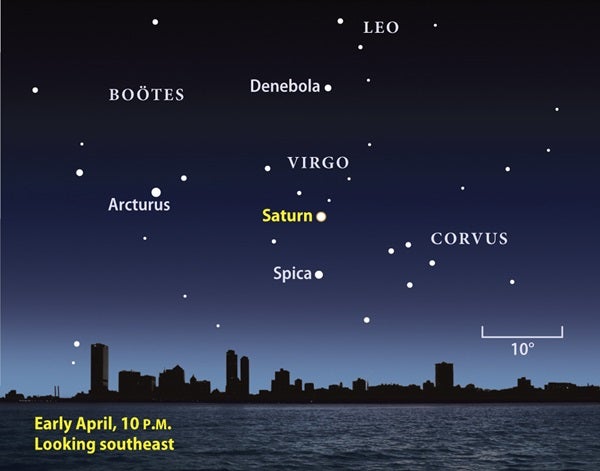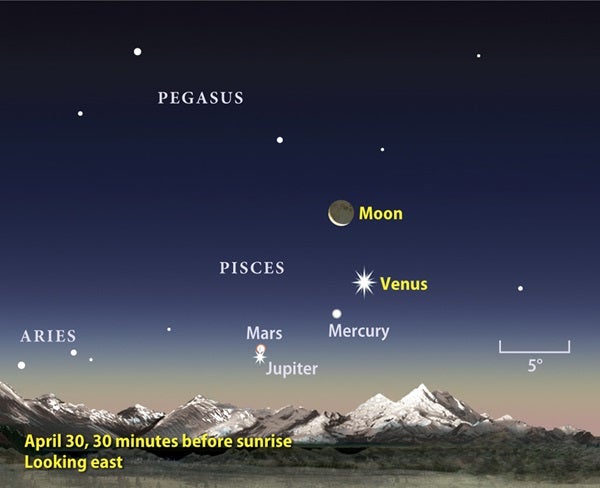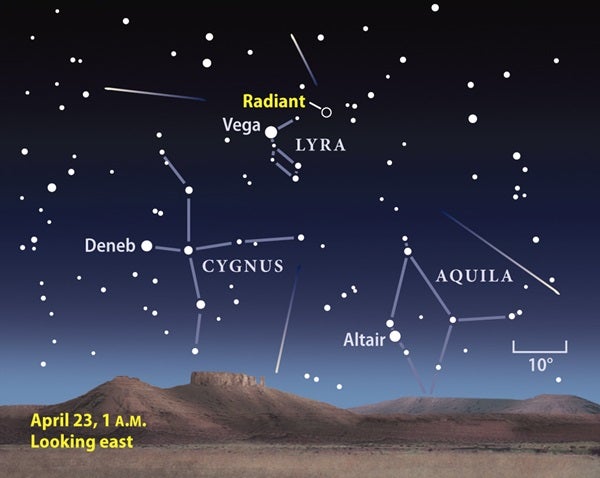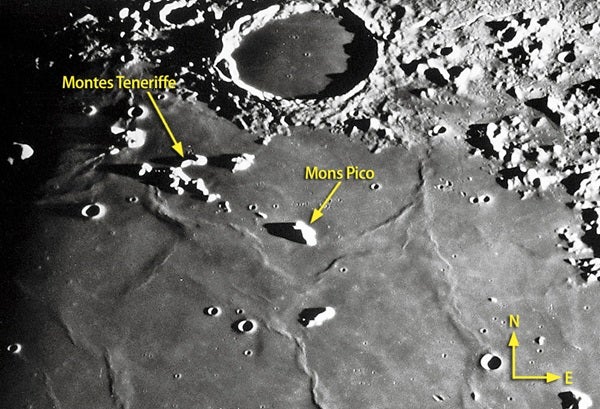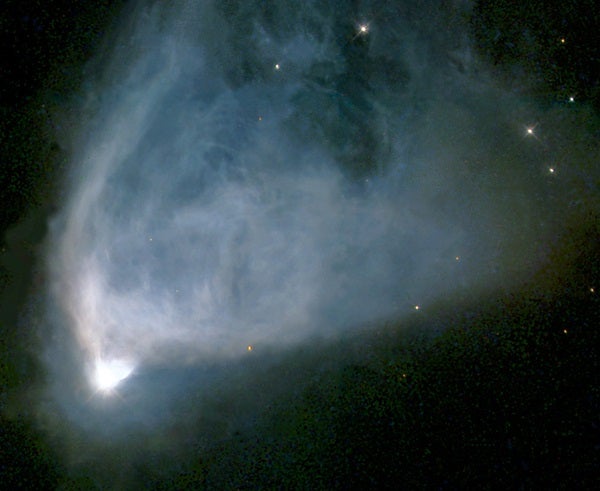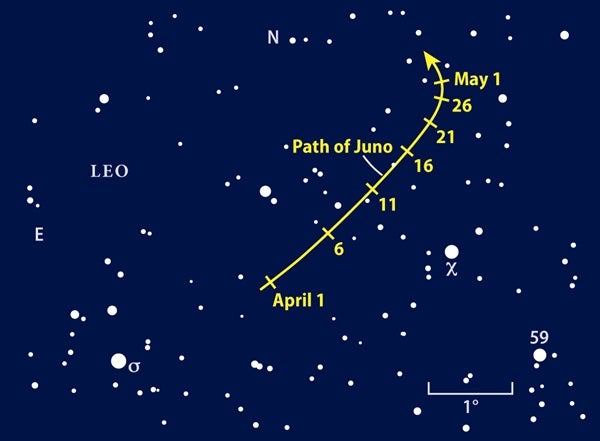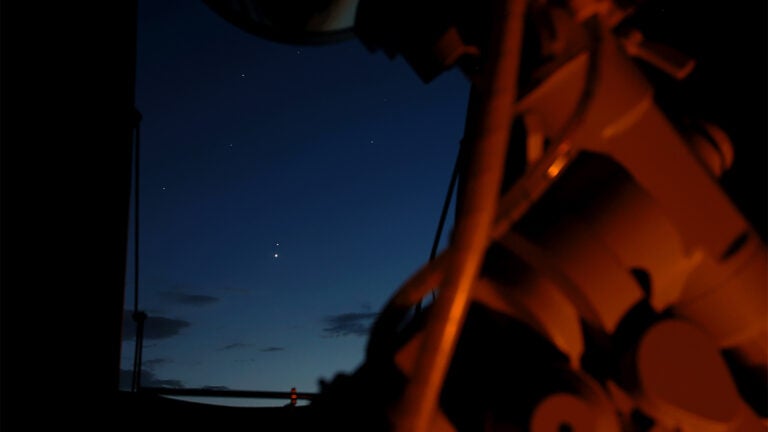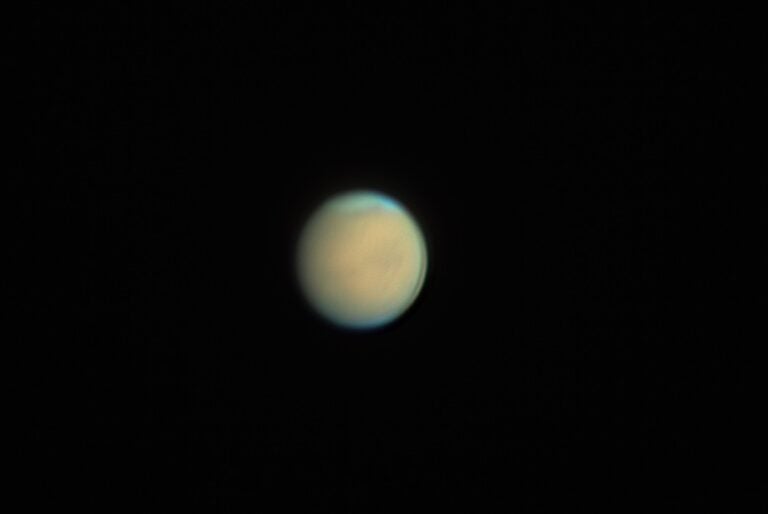Those who like to view planets in bunches will have to wait for the approach of dawn. Venus rules the sky as you sip your morning coffee, a beacon that you won’t mistake for any other celestial object. As April winds down, a closer look will reveal Mercury and Jupiter not far from Venus. Mars, Uranus, and Neptune also gather nearby, but viewing these fainter objects presents a challenge.
Our tour of the evening planets this month is limited because Saturn is the only one clearly visible before midnight. The planet reaches opposition and peak visibility the night of April 3/4, but the view barely diminishes by month’s end. You can find it in the eastern sky as darkness falls. Better views await later in the evening as it climbs in the southeast. Saturn reaches its maximum altitude — when it stands due south and about halfway to the zenith from mid-northern latitudes — around local midnight (1 a.m. local daylight time).
Saturn lies among the stars of Virgo the Maiden. At opposition, it appears roughly midway between 3rd-magnitude Gamma (γ) Virginis and 4th-magnitude Theta (θ) Vir. The planet’s westward motion relative to the background stars carries it to within 2° of Gamma by April 30.
Gleaming at magnitude 0.4, Saturn easily outshines Gamma and Theta. It even beats Virgo’s brightest star, 1st-magnitude Spica, which lies below the planet as they ascend these April evenings. Notice the color contrast between golden Saturn and blue-white Spica.
At opposition, Saturn lies 800 million miles from Earth — its closest approach of the year. This proximity means the planet appears biggest and shows the most detail through a telescope. Saturn’s disk measures 19″ across the equator and 17″ through the poles, a noticeable flattening that arises from a combination of the planet’s gaseous nature and its rapid spin (it rotates once every 10.7 hours).
A small scope also shows the planet’s brightest moon: 8th-magnitude Titan. It orbits Saturn once every 16 days, swinging as far as 3.3′ from the giant world at both greatest eastern and western elongations. You can track Titan daily or simply look for it when it appears closest to the planet (0.5′ away) at inferior or superior conjunction. The moon reaches inferior conjunction and lies due south of Saturn April 1 and 17; it is at superior conjunction and due north of the planet April 9 and 25.
April offers a great opportunity to become familiar with Saturn’s other satellites because they glow brightest at opposition. Three 10th-magnitude moons — Tethys, Dione, and Rhea — are relatively easy to spy through small scopes. Each orbits closer to the planet than Titan and so completes a circuit faster. You can track their relative positions from night to night and, in some cases, even from hour to hour.
At opposition the evening of April 3, you’ll find Titan 2.6′ west of Saturn with Tethys and Rhea barely one-third as far away and a mere 10″ apart. Dione lies on the opposite side of the planet and 1.0′ from the disk’s center. You’ll need an 8-inch or larger scope to spot 12th-magnitude Enceladus, which appears slightly less than half as far from the rings’ eastern edge as Dione does this evening.
With a low-magnification eyepiece, try to find Iapetus. This moon lurks near the outskirts of the main saturnian satellite system. On April 3, it lies 6.4′ west-northwest of Saturn, more than double Titan’s distance. Iapetus reached greatest western elongation in late March, when it also appeared at its brightest (10th magnitude). It fades throughout April as its darker hemisphere turns toward Earth. On the night of April 12/13, look for the 11th-magnitude moon 1.8′ north of Saturn.
Keen observers might glimpse Mercury low in the west just after sunset April 1. It shines at magnitude 2.1 and will be hard to see in the bright twilight. The innermost planet passes between the Sun and Earth April 9, then reappears before dawn at month’s end (see page 47 for details).
The crescent Moon can guide you to the planet’s location April 27. When twilight begins that morning (around 4:30 a.m. local daylight time), Neptune stands about 10° above the east-southeastern horizon with the Moon 6° to its upper left.
Using your binoculars, center on the 4th-magnitude star Theta Aquarii, which appears 1.5° below the Moon. Some 4° from Theta at the 4 o’clock position, you’ll see 5th-magnitude 38 Aquarii. Neptune lies 14′ due south of 38 Aqr and glows 10 percent as bright. The planet shows up through binoculars and is easy to spot with a telescope. Don’t dawdle, however, because dawn will soon drown out Neptune’s faint light.
You won’t need any help to spy Venus before dawn. The brilliant planet shines at magnitude –3.9, making it by far the brightest point of light in the sky. On April 1, it rises around 5:30 a.m. local daylight time. About 5 minutes later, a slender waning crescent Moon rises a bit more than 10° to Venus’ left. (Ten degrees is the approximate width made by your closed fist when held at arm’s length.) The pair appears conspicuous in the eastern sky by 6 a.m.
If you turn a telescope on Venus that morning, you’ll see a disk that spans 13.3″ and appears 80 percent illuminated. Those values don’t change much during April. By the 30th, the planet’s disk measures 11.7″ in diameter and is 87 percent lit. If you have clear skies the morning of April 22, target Venus through a telescope at low power — you might glimpse the 6th-magnitude glow of Uranus just 0.9° north of the bright planet. The faint world will be a challenge to see against the twilight glow.
Look more carefully, and you’ll see Mercury 4° to Venus’ lower left. Shining at magnitude 0.9, it won’t be easy to spot with your naked eyes in the brightening twilight. Binoculars will make this world pop into view. A telescope reveals Mercury’s 9″-diameter disk, which appears about one-third lit. The planet will reach the peak of this morning apparition in May.
Jupiter lurks even closer to the horizon. The giant planet appears just 1° high in the east 30 minutes before sunrise. If it weren’t so bright, shining at magnitude –2.1, it would be invisible against the twilight glow. To locate it, find an observing site with a flat horizon and scan the area with your binoculars about 10° to Venus’ lower left.
Jupiter has company April 30, but you likely won’t see it. Mars lies 0.5° west-northwest of the giant planet but, at magnitude 1.2, it won’t show up in the brightening sky.
Unfortunately, observers at mid-northern latitudes lose out on the best views of this month’s morning planets. That’s because the ecliptic — the apparent path of the Sun and planets across the sky — makes a shallow angle to the eastern horizon at dawn this time of year.
In the Tropics and Southern Hemisphere, however, the ecliptic stands nearly straight up, so the morning planets put on a great show. From 30° south latitude, for example, Venus lies 20° above the horizon 30 minutes before sunrise April 30. Meanwhile, Mercury stands 18° high and Jupiter and Mars are 10° up.
The annual Lyrid meteor shower typically generates up to 20 meteors per hour under optimal conditions. Unfortunately, 2011 won’t be a favorable year. The shower peaks the night of April 22/23, when a waning gibbous Moon shines brightly and will drown out fainter meteors during the predawn viewing hours.
Still, observers should look for brighter shower members the morning of April 23. Lyrid meteors appear to radiate from the constellation Lyra, near the bright star Vega. This region climbs high after midnight and stands nearly overhead as dawn approaches.
For the best views, find an observing location well away from city lights. The Moon rises in the southeast around 1 a.m. local daylight time, so try to position yourself where a tree or building blocks the Moon’s unwanted glow.
Take a peek at these conspicuous peaks
One day after a First Quarter Moon, the Sun starts to rise over the great lava fields of Mare Imbrium. The returning illumination brings into sharp relief a series of mountain peaks that jut from the plains. In their own way, they appear as dramatic through a small telescope as the large oval crater Plato just to their north.
This month, the best views of these mountains come the evening of April 12. Mons Pico ascends about 1.5 miles above the mare floor from a base that spans 10 by 15 miles. Over the course of a single evening, Pico’s triangular shadow grows noticeably shorter. The longer shadows cast by the multiple peaks of Montes Teneriffe retreat even faster because of their more westerly location, where the Sun hangs lower in the early morning sky. Take a peek every 20 minutes or so to get the full effect.
Scientists understand the formation of these mountains thanks to the relatively fresh Mare Orientale impact basin on the Moon’s western limb. A huge impact typically produces a large basin with two or more rings of mountain chains (Orientale has three).
The lava that bubbled up from the ground much later flooded the lowlands, leaving only the tallest peaks of the inner chains poking through. Mons Pico and Montes Teneriffe are the prime examples in the northeastern quadrant of Mare Imbrium. Similar mountain peaks inside Imbrium include Mons Piton on the mare’s eastern shore and Mons La Hire on the western side.
| When to view the planets | ||
| EVENING SKY | MIDNIGHT | MORNING SKY |
| Mercury (west) | Saturn (south) | Mercury (east) |
| Saturn (southeast) | Venus (east) | |
| Mars (east) | ||
| Jupiter (east) | ||
| Saturn (west) | ||
| Uranus (east) | ||
| Neptune (southeast) | ||
Unless 13th-magnitude comets are your cup of tea — and you need a fairly large telescope to find one of them, much less view any details — April won’t supply any refreshment. The good news: Astronomers expect Comet C/2009 P1 (Garradd) to reach 10th magnitude in May, the beginning of a long apparition that should see it remain at least that bright for a year or more. It could peak at 5th magnitude next winter.
This month, keep your observing skills sharp by practicing on a cometlike object in the deep sky. The great English observer William Herschel discovered NGC 2261 December 26, 1783. This fan-shaped reflection nebula looks remarkably like a comet when viewed through a typical backyard telescope.
Although Herschel first spotted the object, it bears the name of American astronomer Edwin Hubble, who discovered in 1916 that NGC 2261 varies in brightness. Hubble’s Variable Nebula lies in the constellation Monoceros, approximately halfway between the bright stars Betelgeuse and Procyon. The nebula’s soft glow lies just 1° south-southwest of the Christmas Tree star cluster (NGC 2264).
Viewing the nebula through a 4-inch scope at low power immediately reveals that this is no star. Crank up the power to 100x and you’ll see its tiny triangular shape. The north side of NGC 2261 fades into the sky like the soft flank of a comet’s dust tail. You’ll need a bigger scope and higher magnification to appreciate the sharpness of the nebula’s southern edges.
NGC 2261 holds a special place in astronomical history. On January 26, 1949, it was the first object photographed through the 200-inch Hale Telescope at Palomar Observatory.
There’s no getting around the fact that despite the three-dimensional nature of the universe, our view of the sky is decidedly 2-D. But you can get a sense of the sky’s depth by watching a solar system object shift position against the starry background. In April, the main-belt asteroid 3 Juno offers a perfect example.
Juno lies an easy star-hop south of Leo the Lion’s hindquarters, a region that lies due south and about two-thirds of the way to the zenith at 11 p.m. local daylight time. To find it, first locate Delta (δ) and Theta (θ) Leonis, the pair of 3rd-magnitude stars that mark the hindquarters’ western edge. Then, drop about 10° south of Theta to Sigma (σ) and Chi (χ) Leo, which are plotted on the finder chart at right. Juno lies in their vicinity all month.
Juno glows around magnitude 9.5 during April, so it won’t stand out in a crowd but will yield to careful star-hopping. German astronomer Karl Harding discovered this asteroid September 1, 1804, from Johann Schröter’s private observatory in Lilienthal, Germany, near Bremen. Harding named the asteroid after the queen of Roman gods.
Martin Ratcliffe
provides professional planetarium development for Sky-Skan Inc. Alister Ling is a meteorologist for Environment Canada.
